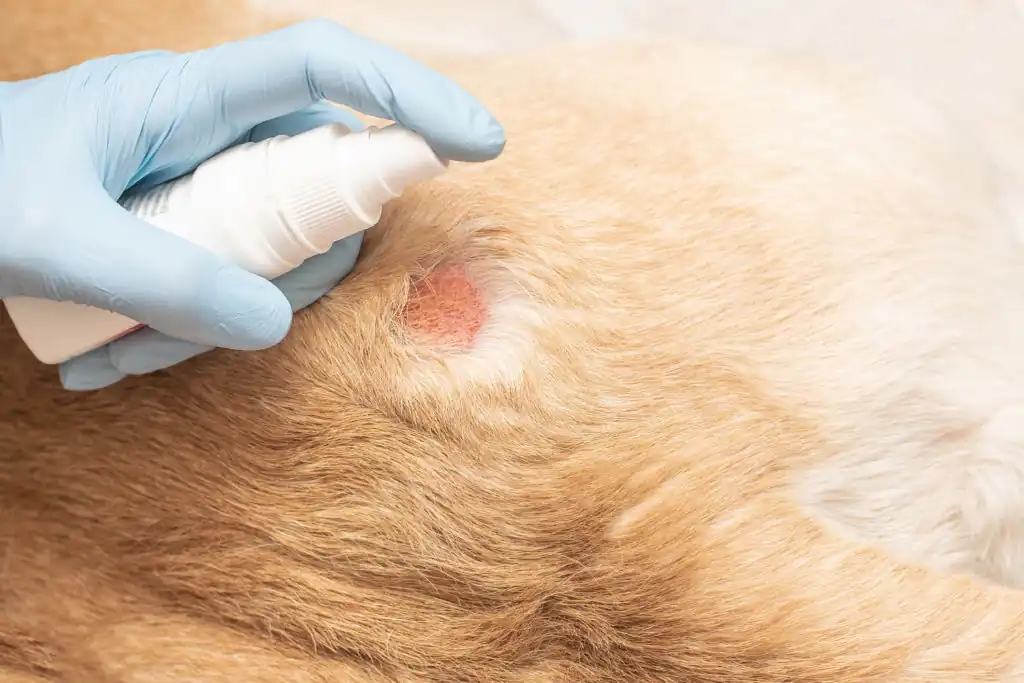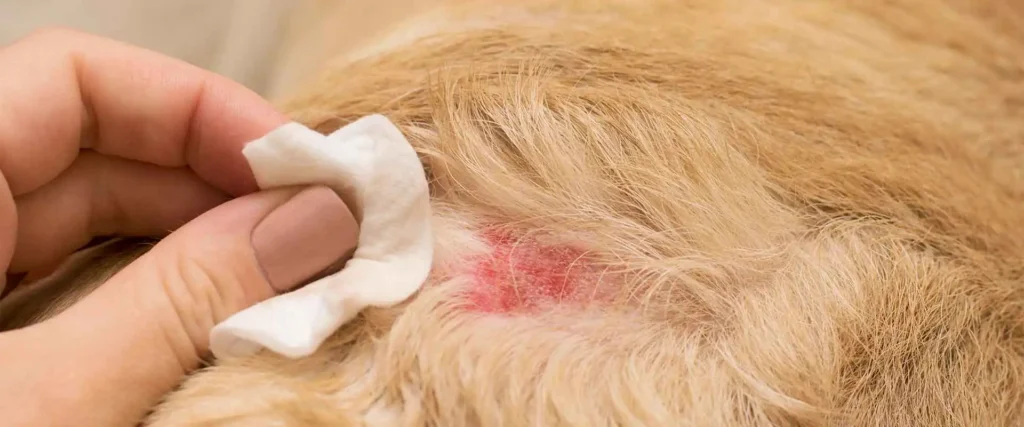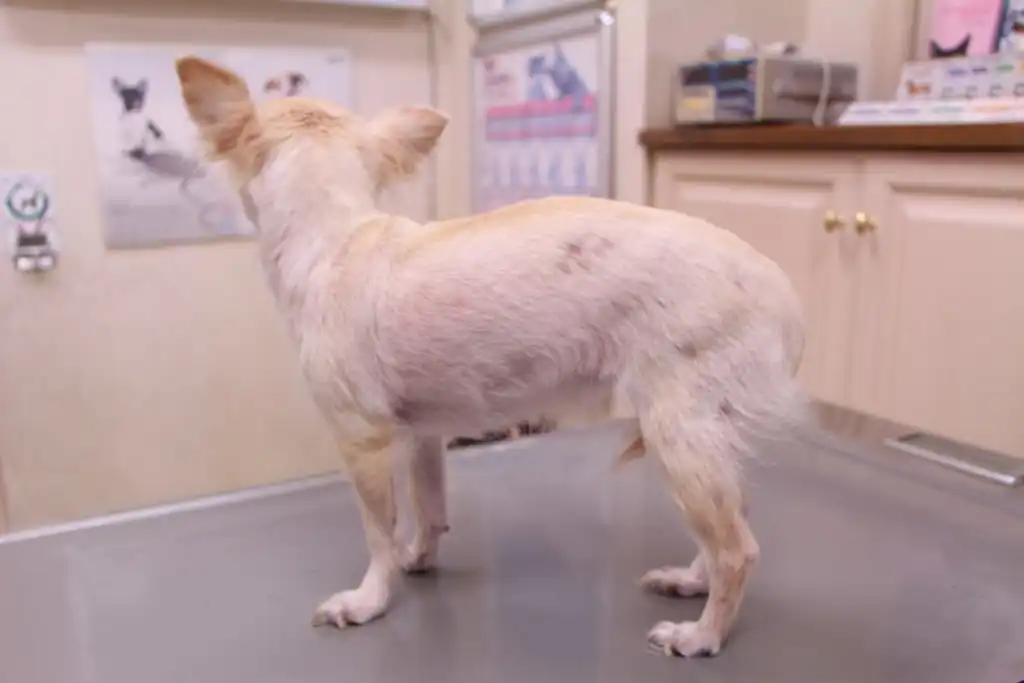There are many types of dog skin diseases, usually dog owners see red, swollen skin, flaking …, etc., will suspect whether it is a skin disease, but there are many types of dog skin disease, there are mange, eczema, allergic dermatitis, ear or eye diseases caused by …, etc., very much so, how to do the dog skin disease? This article tells you the types of dog skin disease, symptoms, preliminary judgment of dog skin disease problems, perhaps without having to see a doctor can be solved!
What are the types of dog skin diseases?

Types of Dog Skin Disease 1, Mange
Mange is an infectious skin disease caused by a parasite, and is also very common in dogs. The main pathogen is a parasite called Sarcoptes scabiei, which produces lesions on the surface of the dog’s skin.
▶ Dog Skin Disease Mange Symptoms:
Itchy, red, swollen skin and hair loss. The dog will lick, bite or scratch the infected area, further aggravating the skin lesions and causing trauma and infection, usually on the head, neck, abdomen and limbs.
Mange is a serious dog skin disease that requires timely diagnosis and treatment. Long-term mange infection can also weaken your dog’s immunity and pose a threat to his health.
Dog Skin Disease 2, Eczema
Dog skin disease eczema, also known as allergic dermatitis, is a non-infectious skin disease usually caused by an allergic reaction to environmental factors. This skin disease can be acute or chronic and usually recurs.
▶ Dog Skin Disease Eczema Symptoms:
Red, itchy skin, blistering, flaking…etc. Dogs may bite, lick, or scratch the affected area, further aggravating skin damage and forming lesions.
▶ Causes of dog skin disease eczema:
Food Allergy: Certain food ingredients (e.g. beef, chicken, wheat, corn, etc.) may cause an allergic reaction in dogs, leading to eczema.
Airborne allergy: Dogs may be allergic to pollen, dust mites, molds and other substances in the air, which may cause eczema.
Contact Allergy: Dogs may be allergic to certain detergents, cleaning agents, perfumes, cosmetics and other substances, resulting in skin damage.
Parasitic infections: Eczema can also be caused by skin parasitic infections such as fleas, ticks and lice.
Immune system disorders: Eczema can be caused by disorders of the dog’s immune system.
Since dog skin disease eczema is usually a chronic condition with many causes, it is recommended that a comprehensive analysis and diagnosis be made from the dog’s diet, living environment, parasitic infections, immune system and other aspects in order to formulate an appropriate treatment plan.
Dog skin disease types 3, pusillanimous herpes
Dog skin disease pusher is a bacterial skin infection, usually caused by Staphylococcus aureus or other bacteria.
▶ Dog skin disease pusher symptoms:
The skin is red, swollen, inflamed and painful.
A pimple-like pus appears on the surface of the skin, which is usually round or oval in shape and varies in size.
When the pus ruptures, the pus flows out and forms an ulcer.
It may be accompanied by fever and loss of appetite.
▶ Dog Skin Disease Abscess Causes:
Parasite infection: Certain parasites, such as fleas, ticks, and lice, can transmit bacteria that can cause an abscess.
Trauma: such as skin cut wounds, or skin puncture wounds, bites and so on.
Disease: Certain diseases (e.g. diabetes, cystitis, etc.) can reduce a dog’s immune system and easily cause an abscess.
Environment: Dogs living in unclean environments, or contact with other dogs infected with an abscess, may also cause disease.
Dog skin disease type 4, ear mite disease
Dog skin disease – ear mite disease is a common canine disease, caused by ear mites parasitized in the dog’s ears. Ear mites are tiny parasites, only about 0.3 millimeters in length, that parasitize the dog’s ear canal and the skin around the ear, causing intense itching and discomfort.
▶ Dog Skin Disease Ear Mite Symptoms:
Dogs will scratch their ears or use their feet to scratch their ears continuously, sometimes making a whining sound.
A brown or black discharge may appear in the ear canal, sometimes with a fishy odor.
The skin around the ears may show rashes, inflammation, and scratch marks.
▶ Dog Skin Disease Ear Mite Causes:
The main mode of transmission of dog skin disease ear mite disease is contact infection, which is often contracted through contact with other dogs with ear mites. In addition, a dog’s living environment that is not clean and hygienic can be a hiding place for ear mites.
If your dog is infected with ear mites, it is important to see your veterinarian for diagnosis and treatment. Treatment for ear mites includes cleaning the ear canal and surrounding skin, using appropriate insecticides to eliminate the mites, and taking care to keep your dog’s living environment clean and preventive measures to avoid re-infection.
Dog Skin Disease Category 5, Allergic Dermatitis
▶ Dog skin disease allergic dermatitis symptoms:
Dogs will continue to lick, bite and scratch the skin, sometimes making a whimpering sound.
The skin may show redness, inflammation, ulcers and hair loss.
There may be flaking or hair loss on the affected skin surface.
▶ Dog Skin Disease Allergic Dermatitis Causes:
Dog dermatosis allergic dermatitis is a type of dog skin disease caused by a dog’s allergy to certain substances or environments, which usually include food, grasses and flowers, dust mites, pollen, and so on.
When a dog is exposed to certain substances or environments, the body’s immune system overreacts, releasing excessive amounts of histamine and other chemicals that cause inflammation and itching of the skin.
There are many ways to treat allergic dermatitis in dogs, such as eliminating foods that may cause allergies, minimizing exposure to substances that may cause allergies, and so on.
If your dog’s allergies are severe, your veterinarian may prescribe antihistamines or steroids to relieve the symptoms. At the same time, it is important to keep your dog’s skin clean and hygienic to avoid re-infection.
Dog Skin Disease Category 6, Folliculitis
Dog skin disease folliculitis is a common canine skin disease, which refers to inflammation and infection of the skin around the hair follicles. Folliculitis can affect any part of the dog’s body, but is most commonly found on the back and near the tail.
▶ Dog Skin Disease Folliculitis Symptoms:
The skin becomes red, swollen, inflamed, and sometimes has pus or sores.
The dog may lick, bite, or scratch the affected area repeatedly because of the pain and discomfort.
Hair may become yellow, brittle, and fall out.
▶ Causes of dermatologic folliculitis in dogs:
Dog dermatophytosis folliculitis may be caused by a variety of reasons, including bacterial infection, fungal infection, parasitic infection, and genetic factors; your dog’s immune system may also overreact to certain foreign substances, causing skin inflammation and folliculitis.
The treatment of dog skin disease folliculitis includes the use of antibiotics, antifungal drugs, anti-inflammatory drugs, such as oral or topical drugs, life, it is recommended to maintain good hygiene habits to avoid the spread of infection.
Dog skin disease type 7, hypertrophic dermatitis
▶ Dog Skin Disease Hypertrophic Dermatitis Symptoms
It usually causes the dog’s skin to become thick, keratinized and fibrous. This type of dog dermatitis may appear in different parts of the body, including the neck, limbs, abdomen and so on.
▶ Causes of Hypertrophic Dermatitis in Dogs
Hypertrophic dermatitis in dogs is a chronic dog skin disease. Hypertrophic dermatitis is related to nutritional, genetic, and environmental factors. Factors such as overfeeding, lack of exercise and obesity may also increase the risk of hypertrophic dermatitis in dogs.
In addition, certain breeds of dogs (e.g. Yorkshire, Pomeranian, Cocker Spaniel, etc.) are more prone to developing hypertrophic dermatitis.
Dog skin disease symptoms include these!

Dog skin disease symptoms vary from cause to cause, and different types of skin diseases have different symptoms, the following are some common dog skin disease symptoms:
Itchiness: One of the most common symptoms of skin disease in dogs, dogs may constantly lick, bite, scratch or rub the affected area.
Redness and swelling: Skin conditions can cause your dog’s skin to become red, swollen and inflamed, sometimes with sores, ulcers or abscesses.
Hair loss: Certain skin conditions can cause your dog’s hair to become brittle and fall out.
Pain: Dogs may experience pain, discomfort or sensitivity due to skin conditions.
Greasiness: Some skin conditions can cause your dog’s skin to become greasy and show signs of seborrheic dermatitis.
Flaking: Skin conditions may also cause flaking and dryness of the skin.
Rash: Skin diseases may also cause your dog to develop a variety of rashes on the skin, such as pimples, blisters, and plaques.
If your dog has one or more of these symptoms, it is recommended that you consult a veterinarian as soon as possible to determine the cause of the disease and provide appropriate treatment options.
What to do about Dog Skin Disease Common QA

In addition to recognizing the types and symptoms of dog skin disease, what are the common dog skin disease problems?
Q1: What to eat for dogs with skin disease?
Protein-rich foods: Chicken, turkey, salmon, etc. as the dog’s staple food.
Foods rich in essential fatty acids: Fish, flaxseed, olive oil and other foods to provide these essential fatty acids.
Vitamins E and C: These vitamins are antioxidants, such as carrots, pumpkin, mangoes, tomatoes, spinach, etc.
Pet supplements: Many supplements strengthen the immune system and can also be used as a complementary treatment for skin conditions in dogs.
Q2: Can dog skin diseases be transmitted to humans?
Some dog skin diseases can be transmitted to humans, this kind of disease is usually caused by bacteria, fungi, parasites or viruses, therefore, when the dog skin disease symptoms, it is recommended to take the dog to the veterinarian in time to avoid human contact with the sick dog or the dog’s belongings to minimize the risk of possible infection.
Q3: Will my dog lose hair if it has skin disease?
The following are some common skin diseases that may cause hair loss in dogs:
1, Allergic dermatitis in dogs
2, Fungal skin infections in dogs
3, Parasitic skin infections in dogs
4, Hormonal imbalance in dogs
Q4、Does dog skin disease heal on its own?
Some dog skin diseases may heal on their own, but it depends on many factors, such as the severity of the disease, the type of skin disease, the dog’s immunity, and the environment in which the dog is kept.
Q5: What is a dog skin disease scab?
Dog dermatosis scabs are hardened, dry and solidified flakes that form on the surface of a dog’s skin. They can form on the surface of the skin, or in the deeper skin tissues underneath the hair, and are often formed around lesions of dermatosis.
The management of dog skin disease scabs usually depends on the specific type of skin disease your dog has, e.g. some conditions require antibiotics or antifungal medications to treat the infection, while others require special bathing routines and emollients to keep the skin moisturized.
Q6、What kind of medication should I rub on my dog for skin disease?
Antibiotics: Used to treat skin diseases caused by bacterial infections such as pyoderma and bacterial dermatitis.
Antifungal drugs: used to treat skin diseases caused by fungal infections, such as psoriasis and candida infections.
Anti-inflammatory drugs: Used to treat skin conditions caused by inflammation, such as eczema and atopic dermatitis.
Insect repellents: For the treatment of skin diseases caused by parasitic infections, such as ear mites and scabies.
Hormones: Used to treat skin diseases caused by severe inflammation and allergic reactions, but should be used with caution as long-term use may lead to side effects.
Q7: Can I bathe my dog for skin disease?
Whether or not it is okay to bathe your dog depends on the specific skin condition your dog is suffering from.
In most cases, dogs can be bathed regularly to keep their skin clean and healthy, especially for dogs that are prone to skin diseases.
However, if your dog is suffering from a serious skin condition, such as eczema or allergic dermatitis, it is best to consult your veterinarian first, as bathing in these cases may stimulate skin inflammation and exacerbate the condition.
5 Ways to Treat Dog Skin Disease

There are many ways to treat dog skin disease and the exact treatment should be determined by the condition, cause and symptoms.
Here are some common dog skin disease treatments:
Dog Skin Disease Treatment – Internal Medications
Antibiotics, antifungals, antivirals, hormones, anti-allergy medications, etc.
Dog Skin Disease Treatment – Topical medications:
Such as ointments, sprays, lotions, insect repellents, etc., used for topical treatment of skin diseases. Some topical medications can also be used to relieve itching and reduce inflammation.
Dog Skin Disease Treatment – Dietary Modifications:
Some skin conditions may be related to your dog’s diet and may require dietary modifications. If your dog suffers from food allergies, a food allergy test may be needed to determine which foods your dog should not eat, as well as a pet food supplement.
Dog Skin Disease Treatment – Environmental Adjustments:
Some skin conditions can be environmentally related, such as mold and parasite infections. Therefore, it is necessary to clean and disinfect your dog’s living environment.
Dog Skin Disease Treatment – Surgery:
Sebaceous adenomas, skin tumors, skin cysts, etc. need to be treated by surgical removal.
